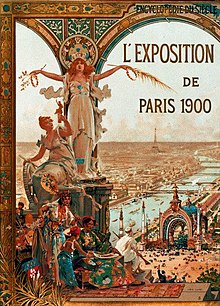Shipping from Europe with tracking number /50mm,Paris by Henri Dubois
Ernest Henri Dubois (March 16, 1863 in Dieppe; December 30, 1930 in Paris), was a French sculptor. He enrolled in 1881 at the École des Arts décoratiif and then attended the École des Beaux-Arts in Paris where he studied under Alexandre Falguière, Henri Chapu and Jules Chaplain. It was his award of the commission to carry out the sculptural work on the tomb of Jacques-Bénigne Bossuet in Meaux Cathedral that gave his career a boost and saw him awarded a Medal of Honour and subsequently he became a Chevalier de la Légion d'honneur.
Exposition Universelle (1900)
| 1900 Paris | |
|---|---|
 Poster | |
| Overview | |
| BIE-class | Universal exposition |
| Category | International Recognized Exhibition |
| Name | L'Exposition de Paris 1900 |
| Building | Grand Palais, Petit Palais, Paris Métro |
| Area | 216 hectares (530 acres) |
| Visitors | 48,130,300 |
| Participant(s) | |
| Business | 76,112 |
| Location | |
| Country | France |
| City | Paris |
| Venue | Champ de Mars, Trocadéro, Bois de Vincennes, Esplanade des Invalides |
| Timeline | |
| Opening | 14 April 1900 |
| Closure | 12 November 1900 |
| Universal expositions | |
| Previous | Brussels International (1897) in Brussels |
| Next | Louisiana Purchase Exposition in St. Louis |
The Exposition Universelle of 1900, better known in English as the 1900 Paris Exposition, was a world's fair held in Paris, France, from 14 April to 12 November 1900, to celebrate the achievements of the past century and to accelerate development into the next. The fair, visited by nearly 50 million, displayed many technological innovations, including the Grande Roue de Paris Ferris wheel, the moving sidewalk, diesel engines, talking films, escalators, and the telegraphone (the first magnetic audio recorder). It also brought international attention to the Art Nouveau style. Additionally, it showcased France as a major colonial power through numerous pavilions built on the hill of the Trocadero Palace. Major structures remaining from the Exposition include the Grand Palais, the Petit Palais, the Pont Alexandre III, the Gare d'Orsay railroad station (now the Musée d'Orsay) and two original entrances of Paris Métro stations by Hector Guimard.
The 1900 Summer Olympics (French: Les Jeux olympiques d'été de 1900), today officially known as the Games of the II Olympiad, was an international multi-sport event that took place in Paris, France, in 1900. No opening or closing ceremonies were held; competitions began on 14 May and ended on 28 October.
The Games were held as part of the 1900 World's Fair. In total, 997 competitors took part in 19 different sports.[1] This number relies on certain assumptions about which events were and were not "Olympic". Many athletes, among them some who won events, didn't know that they had competed in the Olympic Games. Women took part in the games for the first time, and sailor Hélène de Pourtalès, born Helen Barbey in New York City,[2] became the first female Olympic champion. The decision to hold competitions on a Sunday brought protests from many American athletes, who traveled as representatives of their colleges and were expected to withdraw rather than compete on their religious day of rest.
At the Sorbonne conference of 1894, Pierre de Coubertin proposed that the Olympic Games should take place in 1900 in Paris. The delegates to the conference were unwilling to wait six years and lobbied to hold the first games in 1896. A decision was made to hold the first Olympic Games in 1896 in Athens and that Paris would host the second celebration.
Most of the winners in 1900 did not receive medals, but were given cups or trophies. Professionals competed in fencing and Albert Robert Ayat (France), who won the épée for amateurs and masters, was awarded a prize of 3000 francs.
Some events were contested for the only time in the history of the Games, including automobile and motorcycle racing,[3] ballooning,[4] cricket,[5] croquet,[6] Basque pelota,[7] and 200m swimming obstacle race and underwater swimming.[8] This was also the only Olympic Games in history to use live animals (pigeons) as targets during the shooting event.[9]
The host nation of France fielded 72% of all athletes (720 of the 997) and won the most gold, silver and bronze medal placings. U.S. athletes won the second-most in each, while fielding fewer than 8% of the participants (75 of 997).[10]